Saving butterflies, moths and our environment
Celebrating our 40th Anniversary!
1982 - 2022
Paulsgrove Chalk Pits. Today I visited Paulsgrove Chalk Pits where the temperature was 17.5 degrees. Only a handful of butterflies were on the wing, but I did record my first Large Skipper this year. Totals: Large White 1, Small Blue 7, Large Skipper 1. [Posted by Roy Symonds]
Coulters Dean Field Trip. A total triumph today as the weather behaved itself, and after a route march up to the site from the car-park, we were greeted with lots of wild flowers mainly Cowslips and Orchids. Coulters Dean is a wildflower haven sandwiched between a Beech Woodland and Arable Farm Land. Coulters Dean produced some good counts of many species of note were Green Hairstreak, Common Blue, Dingy Skipper, Cinnabar, Six-spot Burnet, Burnet Companion, and Mother Shipton Moths. The site is bordered by some arable farmland and over the past thirty odd years since I've been visiting the site the 'set aside' has been growing in stature, and here we found a very odd specimen, a Marsh Fritillary, where this male had come from was anybody's guess, we also saw Brown Argus, and Small Blue, and many Dingy Skippers and Common Blues here plus the Mother Shipton Moth.There are carpets of Cowslips now, but I'm afraid the Duke of Burgundy has long gone, being so Isolated to re-establish itself here it would have to find its way from Butser Hill, although not far as the crow flies but there are an awful lot of Beech trees to negotiate. Also there is very little scrub of note, so I dont think it would re-colonise here naturally. [Posted by Ashley Whitlock]
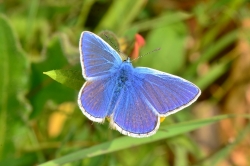 |  | 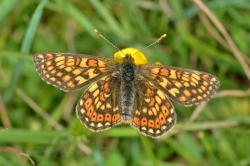 |
| Common Blue lived up its name Photo © Ashley Whitlock | Mating pair of Six-Spot Burnet Moths Photo © Ashley Whitlock | Surprise of the day was a Marsh Fritillary Photo © Ashley Whitlock |
Deacon Hill. Popped in to see another of the less visited Duke of Burgundy sites today at Deacon Hill just south of Winchester.. After battling through chest high nettles and sustaining quite a few stings I eventually located four Dukes two males and two females - the site has become very scrubby but good efforts are being made to complete some rotational clearance. On the way home I called in to see one of Hampshire’s rarest orchids the Man Orchid in the Meon Valley - a lovely specimen . [Posted by Mark Tutton]
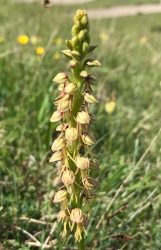 | 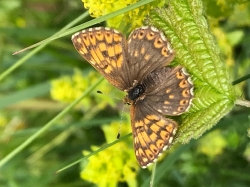 | 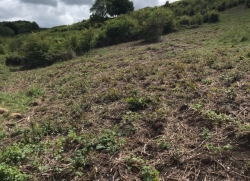 |
| Man Orchid Photo © Mark Tutton | Duchess Photo © Mark Tutton | Scrub Clearance Photo © Mark Tutton |
Broughton Down. Duke of Burgundy. Surprised to see a Duke of Burgundy , on Broughton Down, maybe a stray from somewhere.
Also many Adonis Blues and Brown Argus ,a scattering of Common Blues. 10 Dingy Skipper, just one Grizzled Skipper though. Also 8 Green Hairstreaks. [Posted by Jason Claxton]
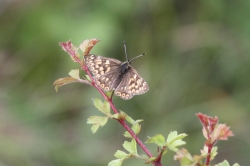 |
| Broughton Down. Duke of burgundy Photo © Jason Claxton |
White Letter Day at Great Fontley. After 18 years and 102 elms, the Great Fontley elm trials site has at last been colonized by the White-letter Hairstreak. After noting typical WLH leaf damage on several cultivars and a White Elm, Paul Harfield spotted a larva on the solitary Japanese Elm, U. davidiana var. japonica. A native of Hokkaido, this elm's phenology is considerably retarded, which probably accounts for the larva's delayed maturity. A later visit to the Ports Down trials site found a predated pupa on a Provencal field elm, confirming the WLH's arrival there too. A little butterfly, but evidently with extraordinary powers of dispersion. [Posted by Andrew Brookes]
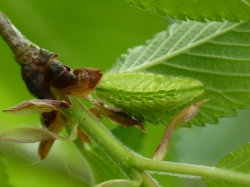 |
| White-letter Hairstreak larva on Japanese Elm, Great Fontley. Photo: Paul Harfield Photo © Andrew Brookes |
Old Winchester Hill. Today I paid my first visit this year to Old Winchester Hill. The weather was sunny but despite the temperature of 20 degrees there was also a strong breeze which probably kept numbers low. I walked along the main ridge and around the hill fort, returning down the stepped path back to the ridge, so did not walk through the wooded area or the car park slope. Totals: Brimstone 13M 3F, Large White 1, Common Blue 2M, Small Heath 5 and Peacock 1. [Posted by Roy Symonds]
More Dukes, in Harewood. 4 found at two sites in Harewood Forest; I was surprised how fresh the males were. Not much else, but a couple of Dingy Skippers, and, best of all, a Large Pearl-bordered Fritillary motored past at 70mph. I don't know how often this species is seen in Harewood - they certainly used to be there - but Harewood (the biggest block of woodland in Hants outside the New Forest, much of it ancient woodland) is lamentably under-watched. However, if you do visit, please, please stick to the footpaths, some owners are interested in butterflies but do not tolerate trespassers! [Posted by David Murdoch]
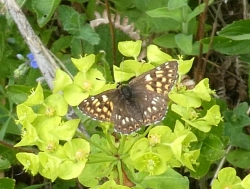 | 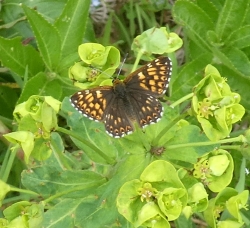 |
| Duchess?? Photo © David Murdoch | Duke Photo © David Murdoch |
Dukes on Stockbridge Down. 2 rather battered Duke of Burgundy at Stockbridge Down [Posted by David Murdoch]
Oxenbourne Down. My last trip up to Oxenbourne Down for the Duke of Burgundy and today they were looking a little bit faded, I only counted (8) as the terrain they live in is not ideal to find them. The best counts today were Common Blue and the Speckled Yellow Moth, of which is the best numbers I've ever seen of this bright coloured Moth I think, they were literally everywhere. Despite the warmth of the weather I only managed (9) species today, but as always it's always a joy to walk around this very secluded site, and listen to the Skylarks and the Buzzards being harassed by Rooks along the valley floor. [Posted by Ashley Whitlock]
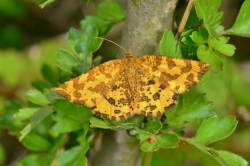 |  | 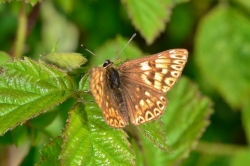 |
| Speckled Yellow Moth very common today Photo © Ashley Whitlock | Green Hairstreak Photo © Ashley Whitlock | Dukes are fading fast on the downland.... Photo © Ashley Whitlock |
Chalton Down, Old Idsworth. Today I visited Chalton Down (SU736156) where the temperature reached 18 degrees. A total of six different species were seen, with a few more Common Blues now appearing. Totals: Brimstone 4M 4F, Small White 1, Common Blue 6M, Green Hairstreak 1, Small Heath 1, Dingy Skipper 1. [Posted by Roy Symonds]
Pitt Down. Made my first ever visit to Pitt Down this morning. I didn't have time to do West Wood justice so will save that for later in the season now that I've found it! A perfect day though for wandering a chalk down. Nothing spectacular - couldn't find any Dukes nor Small Blues for that matter but the Down is carpeted in wild flowers and there are butterflies to see at virtually every step. Countless Dingy Skippers (some a little faded), Grizzled Skippers (most surprisingly fresh) and Common Blues at their very best. Small Heaths were probably the most numerous variety. Mixed in were Green Hairstreaks in the shrubby areas and Brimstone nearer the top of the hill. Looking forward to a repeat visit later in the year. [Posted by Mark Wagstaff]
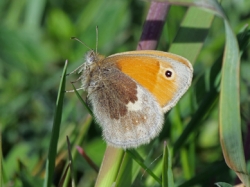 |  | 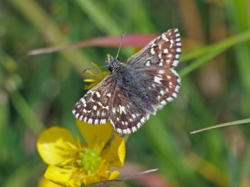 |
| Small Heath - Pitt Down Photo © Mark Wagstaff | Common Blue - Pitt Down Photo © Mark Wagstaff | Grizzled Skipper - Pitt Down Photo © Mark Wagstaff |
More photos of the Martin Down Field Trip. More photos of the Martin Down Field Trip [Posted by Ashley Whitlock]
 |  | 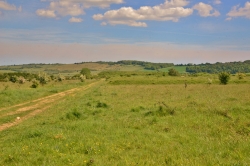 |
| Mating pair of Grizzled Skippers Photo © Ashley Whitlock | Small Blue were everywhere.. Photo © Ashley Whitlock | Martin Down Photo © Ashley Whitlock |
Martin Down Field Trip. A beautiful day greeted me at 0630 as I drew into the car park at Martin Down with the sound of Turtle Doves and the resident Cuckoo Cuck..oooing in the distance, I was really looking forward to the Field Trip. I had seen up to 7 species by 0700 so things were looking good. By the time we had got back to the car-park at 1400 we had seen twenty species of butterflies and moths.The star of the show naturally was the Marsh Fritillary which commanded the stage along Bockerley Dyke along with the little 'Spitfire' Small Blue.We saw in total (74) Marsh Fritillary which is a conservative estimate...and well over (100) Small Blues. Other gems were (38) Adonis Blues with several mating pairs, along with Brown Argus, Grizzled Skipper, and a Large Skipper. On the Moth front we had Burnet Companion, Yellow Shell, Cinnabar Moths, several Footman,and Mother Shipton. It was one of those field trips where everything went just right, the weather the company and the butterflies and moths.... [Posted by Ashley Whitlock]
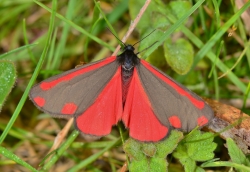 | 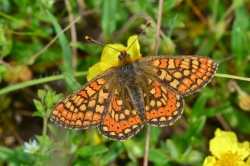 | 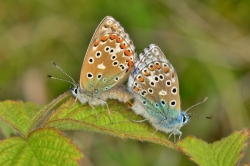 |
| Cinnabar Moth Photo © Ashley Whitlock | Marsh Fritillary Photo © Ashley Whitlock | Mating pair of Adonis Blues Photo © Ashley Whitlock |
Paulsgrove Chalk Pits. Today I visited Paulsgrove Chalk Pits (SU6306) in sunshine with the temperature reaching 20 degrees. Many Small Blues were flying and I also recorded the odd Small Copper and Green Hairstreak as well as my first Brown Argus this year. Totals: Brimstone 1M 5F, Large White 1, Small White 1, Brown Argus 1, Common Blue 11M, Holly Blue 3, Small Blue 19, Green Hairstreak 1, Small Copper 1. [Posted by Roy Symonds]
Martin Down(2). More pics from Martin Down 21/5/19. [Posted by Mark Pike]
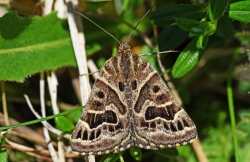 | 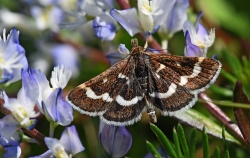 | 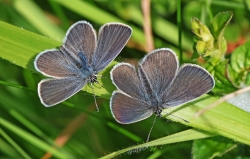 |
| Mother Shipton Photo © Mark Pike | Pyrausta Nigrata Photo © Mark Pike | Small Blues Photo © Mark Pike |
Martin Down. Yet another visit from 0800-1315 produced another superb array of butterflies. Although I didn't cover so much of the area Marsh Frits were still abundant, as were Small Blues. Counts were: Small Blue 38, Common Blue 15, Adonis Blue 10, Holly Blue 5, Brown Argus 20, Green Hairstreak 11, Brimstone 10, Marsh Fritillary 30, Small Copper 15, Speckled Wood 1, Orange-tip 1. Moths, Mother Shipton 1, Pyrausta nigrata 1, Burnet Companion 4, Cinnabar 6. [Posted by Mark Pike]
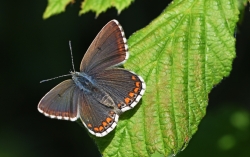 |  | 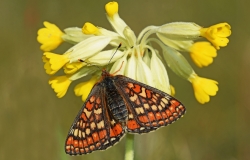 |
| Adonis Blue(female) Photo © Mark Pike | Common Blue Photo © Mark Pike | Marsh Fritillary Photo © Mark Pike |
WLH larvae at Stockbridge. Following yesterday's success when searching for White-letter Hairstreak (WLH) larvae, I had another brief check of some Wych Elms near Stockbridge with signs of eating damage. Once again, I was lucky enough to find a single larva, and I do count myself very lucky, as they have great camouflage. In side profile they look just like the very young elm leaves as they open up. They even have the same fine row of white hairs along the edge. Another thing about these larvae is they really cling on, clearly trusting their camouflage, whereas caterpillars of butterflies in grassland simply drop to the ground at the slightest movement of the vegetation. Understandably, caterpillars in trees can't adopt this strategy as they have to deal with stormy weather, when their branch is being knocked about. Think about that on the next windy day! [Posted by Andy Barker]
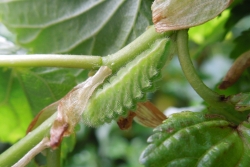 | 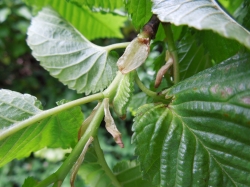 | 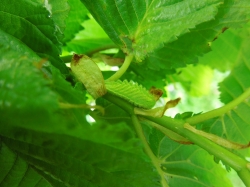 |
| WLH larva (close-up) Photo © Andy Barker | WLH larva - amongst elm leaves Photo © Andy Barker | WLH larva - side view Photo © Andy Barker |
Porton Down Field Trip. More photographs of the trip [Posted by Ashley Whitlock]
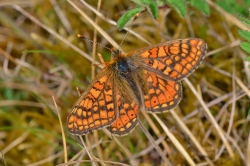 | 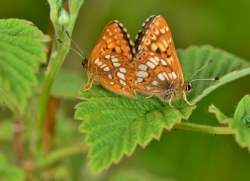 | 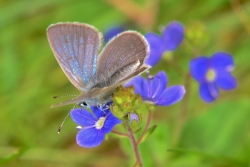 |
| Marsh Fritillaries were only just emerging... Photo © Ashley Whitlock | Mating pair of Duke of Burgundies Photo © Ashley Whitlock | Small Blue on Germander Speedwell Photo © Ashley Whitlock |
Porton Down Field Trip. The weather certainly didn't look good at all today, but as luck would have it the rain stayed away and we had good bouts of sunny and cloudy but warm weather, which was ideal for counting butterflies, for which this exercise was for. Porton Down is a rich tapestry of different environments, with lots of small pockets of open clearings within woodland and these have fantastic areas of Primrose, interspersed with Wild Strawberry and rough grasses. Here the Duke of Burgundy still remains the dominant species (thank goodness) and with the counting over a period of three to four hours the total was a very conservative (83). Several Female Dukes were just emerging and this gives the Duke of Burgundy a very long extended flight period this season. Other areas where Dukes could be found were in areas of open meadow with hundreds of Ant Hills and here the Duke was found also. Other species seen today were Marsh Fritillary, (1) Pearl-bordered Fritillary which was a big disappointment, Brown Argus and Small Blue. There were fabulous Orchids, and other wild flowers only associated with this site. In all we saw (14) species of butterfly along with the Dark-green Fritillary Caterpillar, and several Moth species. We had just got back into our cars when it started to rain.... talk about good timing! [Posted by Ashley Whitlock]
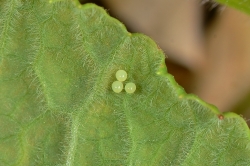 | 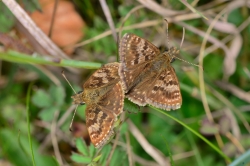 | 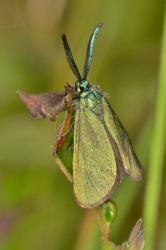 |
| Several female Dukes were seen egg laying on Primulas and here are three eggs. Photo © Ashley Whitlock | Mating pair of Dingy Skippers Photo © Ashley Whitlock | Forester Moth Photo © Ashley Whitlock |
White-Letter Hairstreak Larvae at Pitt Down. I did not go to Pitt Down today expecting to find White-Letter Hairstreak Larvae. I went looking for Small Blue and Duke of Burgundy and failed on both counts. However, I was surprised to find Elm there with feeding damage and subsequently 2x Pre-Pupation White-letter Hairstreak larvae on the western section. Some small branches had oddly been very recently (within the last 24 hrs) removed for no apparent reason and were laying on the ground beneath the tree. One of the larvae was on those branches. A similar tree on the eastern section also had feeding damage, but I could not locate any larvae there. [Posted by Paul Harfield]
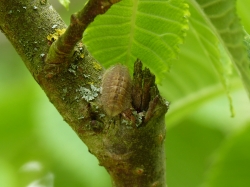 | 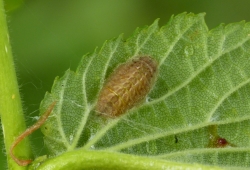 |
| Pre-pupation White-Letter Hairstreak Larva at Pitt Down today Photo © Paul Harfield | A similar Pre-pupation larva found on Elm branches which were lying on the ground Photo © Paul Harfield |
White-letter Hairstreak larva seen near Hursley. Following Paul Harfield's posting of White-letter Hairstreak (WLH) larval images on 5 May, and encouragement for us all to have a look at low branches of elm, I decided I'd have a go this afternoon at a known WLH site near to where I live. The site near Hursley, that I've known since the 1990s, has some nice roadside Wych Elms with convenient low branches. To my surprise, after less than 5 minutes I found a larva under a leaf on one of many branches showing larval feeding damage. I didn't have time for a longer survey today, but will return at a later date. [Posted by Andy Barker]
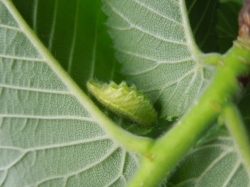 | 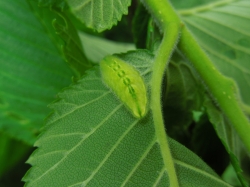 | 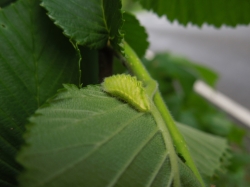 |
| WLH larva (under elm leaf) Photo © Andy Barker | WLH larva (top view) Photo © Andy Barker | WLH larva (side view) Photo © Andy Barker |
Old Winchester Hill Field Trip. Overcast today for the most part but we did have a small window of sunshine when we were at the bottom of the South facing slope off of the Hill Fort and here we saw Small Blue, Adonis Blue, Common Blue, Small Heath, Brimstone, Grizzled Skipper, Dingy Skipper, Orange-tip, and further in from this slope facing North we encountered two Duke of Burgundy still fresh looking. We also had Common Carpet Moth, Mother Shipton and the caterpillar of the Mullian Moth.
All things considered you should never give up on a grey overcast day! [Posted by Ashley Whitlock]
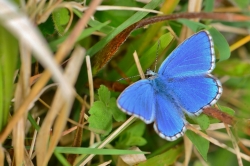 |  | 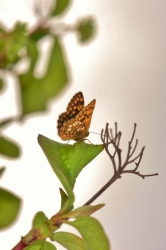 |
| Adonis Blue straight out of the box... Photo © Ashley Whitlock | Female Dingy Skipper Photo © Ashley Whitlock | Duke of Burgundy were utilizing the higher shrubs when the sun went in. Photo © Ashley Whitlock |
Portsdown Hill and Fort Widley. Today I visited the East end of Portsdown Hill (SU657063) where the temperature was 18 degrees.The main species seen were Brimstones. Totals: Brimstone 5M 2F, Common Blue 2M, Speckled Wood 1.
Across the Road at Fort Widley (SU657066) there was much more variety with six different species noted. Totals: Brimstone 2M 2F, Large White 1, Small White 1, Common Blue 2M, Holly Blue 2, Speckled Wood 3. [Posted by Roy Symonds]
West Wood and Pitt Down Field Trip. More photos from the trip [Posted by Ashley Whitlock]
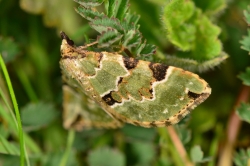 | 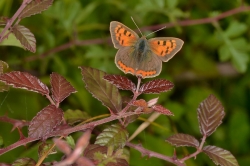 | 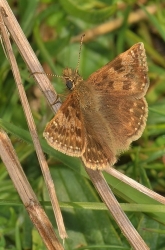 |
| Green Carpet Moth Photo © Ashley Whitlock | Small Copper Photo © Ashley Whitlock | Dingy Skipper Photo © Ashley Whitlock |
West Wood and Pitt Down Field Trip. With the last day of any decent weather for a few days we started the field trip with a view of a Duke of Burgundy on Pitt Down, which doesn't get mentioned much in my records, and into the woodland we encountered several Pearl-Bordered Fritillary feeding on dandelion and Bugle plants. Inside the coppiced area we encountered the Duke of Burgundy still in really good condition and many more Pearl Bordered Fritillaries. We saw a Fox Moth male on the woodland floor but it looked well past its best and wouldn't fly so I don't know whether it had encountered a bird strike as its left hind wing was frayed. (12) Species of moth and butterflies were encountered in the wood with Pearl-bordered Fritillary (11) and Duke of Burgundy (8). On Pitt Down I saw another Duke on the woodland side at the bottom of the downland, and there were several species that added to the list like Small Heath, Small Copper, Small Blue, Common Blue, Comma, Green Hairstreak,and a lovely Smooth Snake and Green Carpet Moth.
Thank you all for coming on making this a great feast of invertebrates! [Posted by Ashley Whitlock]
 |  | 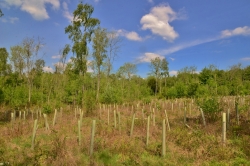 |
| Male Fox Moth Photo © Ashley Whitlock | Male Duke of Burgundy Photo © Ashley Whitlock | West Wood Photo © Ashley Whitlock |
Plenty Of Spring Butterflies On Portsdown Hill. A walk on Portsdown Hill this morning produced an excellent display of spring butterflies. On the lower slopes below the Paulsgrove quarry, Small Blues were flitting around the path and scrubby vegetation. At least 20 were present including a couple of females, mingling occasionally with Common Blues. Just to the east of the quarry on the central section of the hill, there were a few more Small Blues but here they were outnumbered by Common Blues.
The highlight of this area however, was one section of mixed hedgerow with hawthorn fronted by plentiful dogwood, where several Green Hairstreaks were engaged in territorial battles - up to 3 at a time, lasting several minutes. They eventually settled for a few photos! Other species seen included Orange-tip, Brimstone, Speckled Wood, Holly Blue and Green-veined White. [Posted by Alan Thornbury]
 |  | 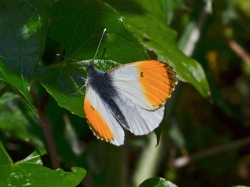 |
| Small Blue Photo © Alan Thornbury | Green Hairstreak Photo © Alan Thornbury | Orange Tip Photo © Alan Thornbury |
P.b.f in the New Forest. With the Pearl-bordered Fritillary season hitting peak about now i undertook a count away from the core areas to see how it's doing. The weather was very sunny with a breeze. Finished the day on 291 p.b.f with 2 pairs in copulation, 17+ ovipositing females and a male being eaten by a crab spider! Still plenty of other rides I never had time to see. Also seen 5 Green Hairstreaks and a Grizzled Skipper [Posted by M swann]
Martin Down(2). More pics from Martin Down. [Posted by Mark Pike]
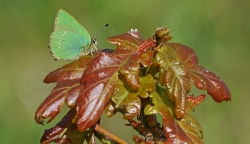 | 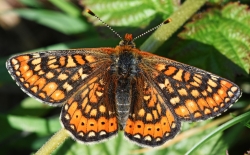 | 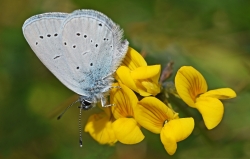 |
| Photo © Mark Pike | Photo © Mark Pike | Photo © Mark Pike |
Martin Down. A visit today from 0900 to 1345 produced a wonderful array of butterflies, but I have never seen quite so many Marsh Fritillary here, at least 40 from all over the site but suspect there were more! Apart from this bonanza other species seen were Brown Argus 16, Small Blue 22, Common Blue 8, Adonis Blue 12, Green Hairstreak 10, Small Copper 12, Grizzled Skipper 10, Dingy Skipper 24, Brimstone 10, Orange-tip 5, Red Admiral 2, Peacock 3, Speckled Wood 1. [Posted by Mark Pike]
 | 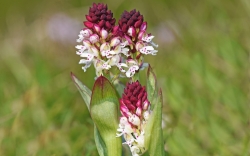 | 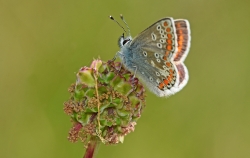 |
| Adonis Blue Photo © Mark Pike | Burnt Tip Orchid Photo © Mark Pike | Brown Argus Photo © Mark Pike |
Large Skipper on the Isle of Wight.. I saw my first Large Skipper today close to Stag Lane,Cowes. [Posted by Peter Hunt]
 |
| Photo © Peter Hunt |
Chalton Down, Old Idsworth. After visiting Oxenbourne Down, I headed to nearby Chalton Down (SU736156) where the temperature had increased to 18 degrees. A total of six species were recorded, although no Grizzled Skippers have appeared here yet. Totals: Brimstone 6M 1F, Small White 1, Common Blue 5M, Holly Blue 1, Small Heath 6, Dingy Skipper 2. [Posted by Roy Symonds]
Oxenbourne Down. Today I made a return visit to Oxenbourne Down (SU716183) where the weather was much better than my previous visit, the temperature reaching a respectable 17 degrees. A total of five species were seen including Dingy Skippers, my walk just covering the main scrubby areas. Totals: Brimstone 4M 2F, Orange-tip 1M, Common Blue 3M, Small Heath 3, Dingy Skipper 8. [Posted by Roy Symonds]
New Forest Pearl Bordered Fritillaries. Having read Ashley's report from the weekend and with the weather set fair I changed plans and went to the New Forest today - roughly the same area around Pignal and Parkhill Inclosures. The Pearl-bordered Fritillary were out in abundance - another enthusiast counted 70+ from the Standing Hat CP to the start of the Frohawk Ride. Just about all were fresh although I was late getting there so very active in the hot sun. My real goal though was to see a Raft Spider (mentioned in Ashley's report). With his help (and a lot from above) I managed to find one! 'Spider' hardly does this amazing creature justice - it was huge! (have included a picture - I appreciate it might not be appropriate on a butterfly web site so quite understand if it is removed during submission). A near perfect day! [Posted by Mark Wagstaff]
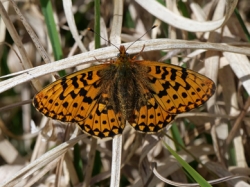 | 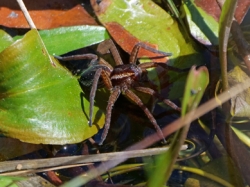 | 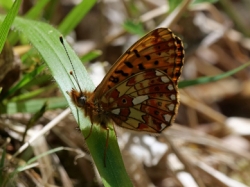 |
| Pearl Bordered Fritillary - Pignal Inclosure Photo © Mark Wagstaff | Raft Spider - Parkhill Inclosure Photo © Mark Wagstaff | Pearl Bordered Fritillary - Parkhill Inclosure Photo © Mark Wagstaff |
Stockbridge Down Field Trip. It pays to visit a site very early in the morning and while most of you were still asleep I was on Stockbridge Down as the sun was rising catching Pearl Bordered Fritillaries having breakfast.....!As I knew they were going to be flying at Mach 3 by the time the field trip started I thought I would seize the opportunity. I had already counted (20) Small Copper around the car park area by 10:30, and by the time the field trip had ended I had counted (52). Other good numbers were Grizzled Skipper (25) Pearl-bordered Fritillary (9) Brimstone over (100) Small Heath (25) along with Common Blue. Sadly the Duke count was very modest with a count of (2).
13 Butterfly species and two moth species was very good and the weather certainly played its part. [Posted by Ashley Whitlock]
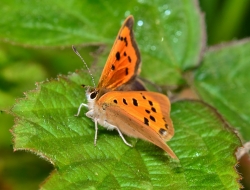 | 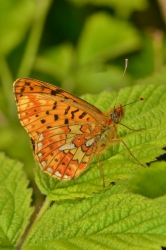 | 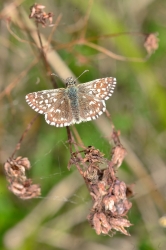 |
| Small Copper were everywhere... Photo © Ashley Whitlock | Pearl Bordered Fritillary at 07:00 Photo © Ashley Whitlock | Grizzled Skipper again quite common Photo © Ashley Whitlock |
Paulsgrove Chalk Pits. Today I visited Paulsgrove Chalk Pits (SU6306) where my target was the Small Blue. The temperature was 16.5 degrees. I recorded nearly a dozen in mostly one area along with Common Blues and a few Holly Blues too. Totals: Brimstone 3M, Small White 1, Orange-tip 1M, Common Blue 5M, Holly Blue 3, Small Blue 11. [Posted by Roy Symonds]
Brimstone Courtship, Chappett's Copse Nature Reserve. An orchid trip to Chappett's Copse Nature Reserve at 1pm on 13th May provided an opportunity to take this photograph of a female Brimstone apparently rejecting a male by pretty extreme contortions of her body. Plenty of Holly Blues and Speckled Woods present, and the sword leaved helleborines are coming into flower. [Posted by Ashley Ailes]
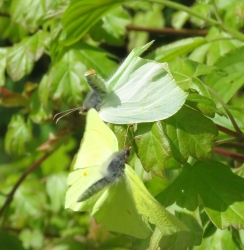 |
| Male and female Brimstone courtship at Chappett's Copse Photo © Ashley Ailes |
Meon Valley. In perfect conditions today I visited several Duke of Burgundy sites and they are still emerging many I saw were in perfect condition. At Westbury Park the count was (13) which is a triumph, as I normally see just 5-6 here, but I suppose I have just managed to catch the peak time for this species. Other species today were good Green Hairstreak several males were interacting with females and buzzing around each other for what seemed like hours. A fresh Brown Argus was seen and Small Blues were also on the wing with Common Blues, Small Heath was out in good numbers as well along with Dingy Skippers, but its close cousin struggled with just 3 being seen. All in all a total of (17) species were seen. [Posted by Ashley Whitlock]
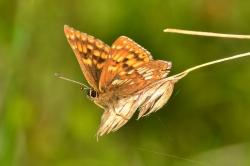 | 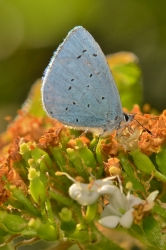 | 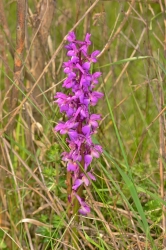 |
| Its still freshers week Photo © Ashley Whitlock | Holly Blue Photo © Ashley Whitlock | Early Purple Orchid Photo © Ashley Whitlock |
West Wood, Farley Mount. very productive short walk around part of West Wood produced the following;6 Pearl-bordered Fritillary, 3 Duke of Burgundy, 1 Grizzled Skipper,1 Small Heath,1 Small Copper,2 Holly Blue,3 Peacock,numerous Brimstone,11 Orange-tip,1 silver ground carpet moth. Very surprised not to see a speckled wood. [Posted by Kevin Ross]
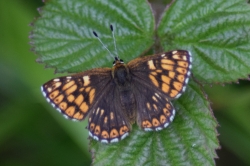 | 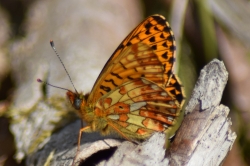 | 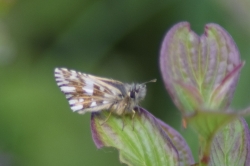 |
| Photo © Kevin Ross | Photo © Kevin Ross | Photo © Kevin Ross |
New Forest Field Trip. Some more photos from field trip [Posted by Ashley Whitlock]
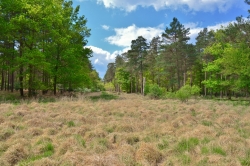 |  | 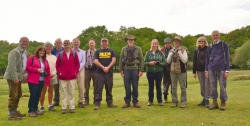 |
| Ramnor Inclosure typical Pearl Bordered Habitat Photo © Ashley Whitlock | Broad Bordered Chaser Photo © Ashley Whitlock | Class of 2019 Photo © Ashley Whitlock |
New Forest Field Trip. Its always nice to start off the field trip in good sunny weather and today made a pleasant change, and from the car park it wasn't long before we had encountered our quarry the Pearl-bordered Fritillary. They all looked particularity fresh with several being seen with bent antennae and looking rather wobbly on their legs, which is a sure sign they hadn't hatched long before we saw them. We walked from Pignal Inclosure into Parkhill Inclosure and then through Ramnor Inclosure, and we counted well in excess of (70) individuals there were obviously many more than that as they were at times flying in two's and threes. On the way we saw several Raft Spiders, which is a very handsome beast lying on the sphagnum mosses in the damp areas, several newly hatched Broad Bordered Chasers were just sitting on Hawthorn bushes sunning themselves before going on the hunt and several common Lizards. Several Tiger Beetles were also seen in the rides as well. Other butterflies seen were Brown Argus, Orange-tip, Speckled Wood, Small Copper and Brimstones. We heard the Cuckoo in the distance and heard Blackcaps and warblers singing in the trees and shrubs along the way.
A fabulous field trip and I thank all those who joined me looking at the various wildlife the New Forest has to offer. [Posted by Ashley Whitlock]
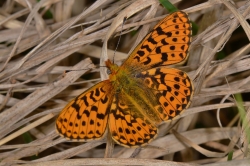 |  | 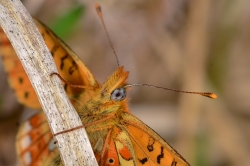 |
| Pearl Bordered Fritillary Male Photo © Ashley Whitlock | Pearl Bordered Fritillary Female Photo © Ashley Whitlock | Head of a Pearl Bordered Fritillary Photo © Ashley Whitlock |
Beacon Hill. Paid an early visit to Beacon Hill this morning to check out the tiny colony of Dukes here. Despite a reasonable amount of what appears to be suitable habitat they seem largely confined to an area about 200m square. I have visited for the last seven or eight years and only once have I seen them outside their “home.” In all I spotted five individuals including a nice Duchess. Green Hairstreak are doing well with one or two in virtually every bush and there were pleasingly a good count of Small Copper and Dingy Skipper. A lovely bright warm morning. [Posted by Mark Tutton]
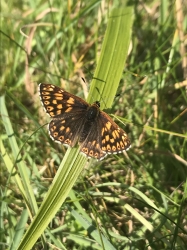 |  |
| Duchess Photo © Mark Tutton | Green Hairstreak Photo © Mark Tutton |
Stoke Common, Hayling Island. Today I visited Stoke Common, Hayling Island (SU716033) where the temperature was 15 degrees.Five different species were recorded. Totals: Large White 2, Small White 7, Orange-tip 2M, Holly Blue 1, Peacock 2. [Posted by Roy Symonds]
Gurnard IOW. Wall Brown in the garden today resting on a small dry stone wall that I built for plants. [Posted by Mick Sivell]
first small coppers in North Baddesley. First Small Copper (2) of the year seen on my butterfly reserve in North Baddesley. As the site is very open small copper are always late compared to some other sites but this is earliest ever. Also seen today: Peacock (12), Small Tortoiseshell (1), Comma (1), Orange-tip (minimum 45, males and females), Brimstone (12),Holly Blue (4),Green-veined White (5), Cinnabar moth (1)and Speckled yellow moth (3). [Posted by Kevin Ross]
 |
| Photo © Kevin Ross |
Martin Down - A Few More. A few more from Martin Down today [Posted by Mark Wagstaff]
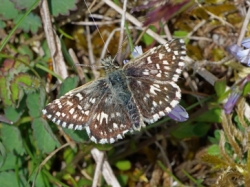 |  | 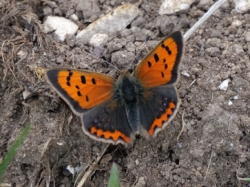 |
| Grizzled Skipper - Martin Down Photo © Mark Wagstaff | Green Hairstreak - Martin Down Photo © Mark Wagstaff | Small Copper - Martin Down Photo © Mark Wagstaff |
Martin Down. Visited my favourite site today and wasn't disappointed. Mixed weather - clouds and sun with a cold wind but plenty to find by the Dyke. The Marsh Fritillary are there - I'm not good at counting (birds or butterflies) but easily into double figures and all fresh. As another enthusiast commented - they look like stained glass windows! Lots of Brimstone and skippers (Grizzled Skipper and Dingy Skipper - some of the latter already looking a little worn). Also Green Hairstreak, Peacock, Small Heath and Small Copper. If there was anything negative then I didn't see a blue of any sort and didn't hear a Turtle Dove - but I suspect I'm a few days early for both. Wonderful place! [Posted by Mark Wagstaff]
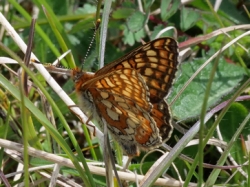 | 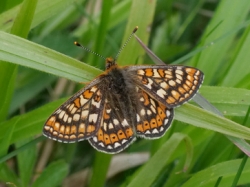 |  |
| Marsh Fritillary - Martin Down Photo © Mark Wagstaff | Marsh Fritillary - Martin Dowen Photo © Mark Wagstaff | Marsh Fritillary - Martin Down Photo © Mark Wagstaff |
Chalton Down, Old Idsworth. Today I visited Chalton Down (SU736156) where the sun had come out after a trip to Oxenbourne Down in cloudy skies, where I saw just two male Brimstones. Here at Chalton Down the temperature reached 14 degrees and I was pleased to record my first Common Blue and Grizzled Skipper of the year. Totals: Brimstone 2M, Small White 1, Orange-tip 1M, Common Blue 1M, Small Heath 2, Dingy Skipper 1, Grizzled Skipper 1. [Posted by Roy Symonds]
Old Winchester Hill. Unbelievably there are still some Duke of Burgundy sites where the species is still emerging and this is one today where I really struggled to find them. I managed just four all very fresh looking, and with this site being so large its best to concentrate on one slope so I did the North or North West facing slope. Here the Cowslips are not abundant, as there are sheep feeding all over the site and obviously they will eat Cowslip, given half a chance, which in turn keeps the Duke of Burgundy numbers down. The specimens I did see were well spread out, I never saw any two together. There were Brimstone, Dingy Skipper, Grizzled Skipper and Small Copper on the wing with just one Common Blue. The weather played a part as well with sun appearing in very small amounts between large areas of cloud. [Posted by Ashley Whitlock]
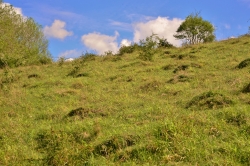 | 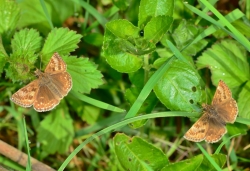 | 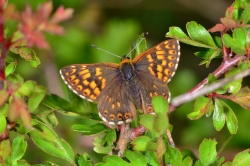 |
| Typical Duke of Burgundy area on OWH Photo © Ashley Whitlock | Dingy Skippers Photo © Ashley Whitlock | Male Duke of Burgundy on Hawthorn Photo © Ashley Whitlock |
Oxenbourne Down. After visiting Chalton Down, I visited nearby Oxenbourne Down (SU716183) walking the lower scrubby slopes. The temperature had dropped slightly and despite the small numbers of butterflies, I did record my first Green Hairstreak of the year just inside the entrance.Totals: Brimstone 2M, Green Hairstreak 1, Small Heath 3. [Posted by Roy Symonds]
Chalton Down, Old Idsworth. Today I paid another return visit to Chalton Down (SU736156) where the weather was slightly warmer at 14 degrees. Despite this only three species were recorded; Brimstone 2M, Small White 1, Small Heath 3. [Posted by Roy Symonds]
Glanvilles on the landslip at Compton Chine. Up to 10 Glanville Fritillary including a mating pair seen on the landslip at Compton Chine.Also 3 Common Blue,2 Small Heath,a Small Copper,a Dingy Skipper and 4 Green Hairstreaks. [Posted by Peter Hunt]
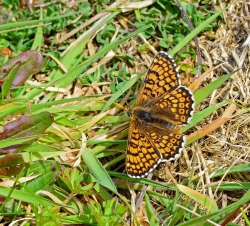 | 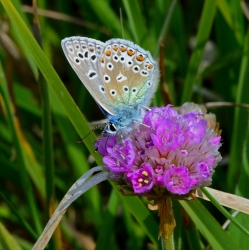 | 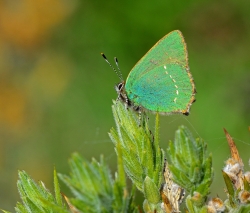 |
| Photo © Peter Hunt | Photo © Peter Hunt | Photo © Peter Hunt |
Oxenbourne Down. I'm Happy to report the Duke of Burgundy is alive and well at Oxenbourne Down with up to (12) being seen today including a mating pair which proves they must be happy with the environment as it stands at the moment.There were counts of Dingy Skipper and Grizzled Skipper, Brimstone, Small Heath, and a single Green Hairstreak.
I think there may well be another colony of Dukes on the top of the down where there were once a large stand of conifers, as I seem to see odd ones on the transect path at the top of the down, which is good as they seem to be spreading out. [Posted by Ashley Whitlock]
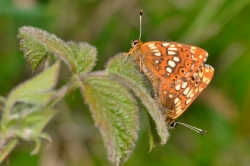 | 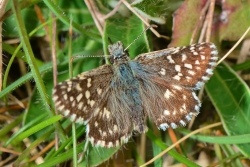 | 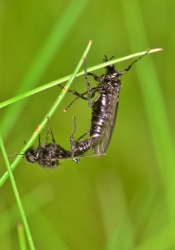 |
| Mating Pair of Duke of Burgundy Photo © Ashley Whitlock | Grizzled Skipper Photo © Ashley Whitlock | Pole-vaulting mating flies Photo © Ashley Whitlock |
Westbury Park. Today looked a non starter for looking for butterflies it was really cloudy right up to about 0930 and I went for it and I was really glad I did as the Duke of Burgundy didn't disappoint. In several secluded areas this species is very hard to find but in a very warm 20-30 minutes after I had been over the same ground in very cool weather, I thought I would give it one last try. And low and behold several males were seen having fisticuffs and several females were noted keeping out of the fray. I was very pleased to count up to (7). There wasn't a lot else a few Orange-tips, Speckled Wood, Holly Blue, and a worn Comma. [Posted by Ashley Whitlock]
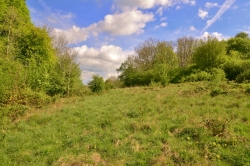 | 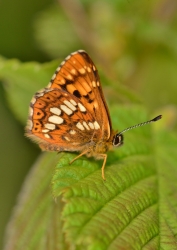 | 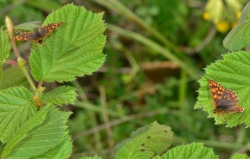 |
| The main arena with good clumps of Cowslip Photo © Ashley Whitlock | Male at rest probably emerged on the 06 May Photo © Ashley Whitlock | The Dukes of Hazel..... Photo © Ashley Whitlock |
Chalton Down, Old Idsworth. Visited Chalton Down (SU736156) in the late morning, the weather became overcast later, the temperature 12 degrees. A few male Brimstones were flying in the sheltered spots and later after the skies had become overcast, I disturbed a resting Small Heath, my first sighting of this butterfly this year. Totals: Brimstone 3M, Small White 1, Small Heath 1. [Posted by Roy Symonds]
Fort Widley, Portsdown Hill. Visited Fort Widley, Portsdown Hill (SU657066) this morning where in sunny spells the temperature reached only 11.5 degrees. Only single sightings of Green-veined White, Holly Blue and Speckled Wood were seen. [Posted by Roy Symonds]
Monks Walk, Frater Fields & Woods, Gosport. Two hours from midday with some sunny periods between the clouds (around 15 degrees) ten types were recorded. Many were grounded seeking shelter from the occasionally strong breeze and/or just trying to warm-up. Numbers: Large White (1); Small White (5); Green-veined White (3); Holly Blue (5); Orange-tip (F)(2); Small Tortoiseshell (1); Speckled Wood (6); Red Admiral (1); Peacock (1); Comma (1). [Posted by Francis Plowman]
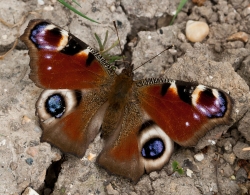 | 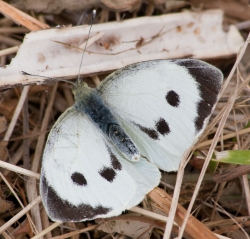 |  |
| Peacock, almost pristine! Photo © Francis Plowman | Large White female Photo © Francis Plowman | Comma Photo © Francis Plowman |
Martin Down. Started at Sillen's Lane end and followed the path along the hedge. Up to five Holly Blue - all of which landed and three of which gave topside views, also Orange-tip, Small White, Speckled WoodS, Small Copper and several Green Hairstreaks.
Carried on straight across the site towards Bokerley and saw a Grizzled Skipper and 4 Small Coppers.
Working along Bokerley (away from the Butts) there were Brimstones, a couple more Small Copper, a Peacock, single Brown Argus, Small Heath, male Orange-tip and too many Dingy Skippers and Grizzled Skippers to count - it fantastic to see!
Down at the 'Hotspot'where the dyke dips down and there is the small wood there were some more Grizzlies and Dingies, a Small White, Green Hairstreaks and a Marsh Fritillary.
On the walk back to the car more of the same but the grass seemed to be alive with Dingies. Once back at the car Tick check; Me 3, Ticks 0! [Posted by Rich Wurzel]
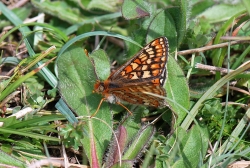 |
| Photo © Rich Wurzel |
West Wood. A few hours walking around a very scrubby area within West Wood near to Winchester on a very cool day with sunny periods which were quite warm at times. This produced (7) Pearl-bordered Fritillary and (6) Duke of Burgundy and one solitary Speckled Wood and nowt else!
This site is an area of cut down forest which has been replanted with Hazel and other trees and shrubs. It is lightly covered in Primroses where the Duke breeds, but either species are not evident at first or to the untrained eye.... as there is a lot of Bramble to negotiate. One of the Pearl-Bordered Fritillaries was seen in (Ashleys ride)!
I'm really surprised I haven't had any reports of Duke of Burgundy from Pitt Down which is covered in Cowslips and is very scrubby just right for the Duke of Burgundy, I await a report..... [Posted by Ashley Whitlock]
 | 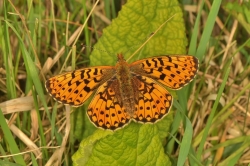 |  |
| Woodland Duke of Burgundy on Primrose very fresh..... Photo © Ashley Whitlock | Pearl-Bordered Fritillaries were very fresh as well... Photo © Ashley Whitlock | Old Blue eyes is back! Photo © Ashley Whitlock |
Martin Down National Nature Reserve. There were at least two cuckoos at MD during the cold and cloudy afternoon; one, the feathered variety repeatedly and misguidedly announcing the coming of summer, the other shod in 'size 10 large' clutching a camera and looking for butterflies! A black cloud was stuck above the reserve until around 3 pm when a milky whiteness drew me out of the car for a quick circulation. One (1) brave Brown Argus put in an appearance although two nice ladies I met said they had earlier seen a Small Copper! As it was my first Brown Argus of the year coupled with a family celebration in the area it wasn't a complete waste of time. But it was so cold! [Posted by Francis Plowman]
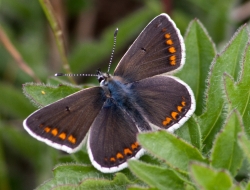 |
| Photo © Francis Plowman |
White-Letter Hairstreak Larvae, Old Winchester Hill. If you can find Elm with low branches NOW is a great time to be out looking for White-Letter Hairstreak larvae. They are really well camouflaged but with a bit of patience they can be found. I quickly managed to locate half a dozen at Southwick yesterday. Today I was pleased to locate just 2 at Old Winchester Hill, but they required a bit more effort. All larvae found were between 10mm and 15mm in length. [Posted by Paul Harfield]
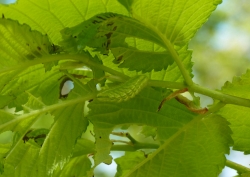 | 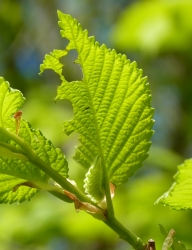 |  |
| Old Winchester Hill Photo © Paul Harfield | Old Winchester Hill Photo © Paul Harfield | Southwick Photo © Paul Harfield |
Duke of Burgundy at Noar Hill. Two very fresh Duke of Burgundy males seen in chalk hollow, west of information board. Flying during brief sunny spell. [Posted by Jacki Solman]
 |
| Duke of Burgundy at Noar Hill Photo © Jacki Solman |
Butser Hill. More Photos of the field trip [Posted by Ashley Whitlock]
 | 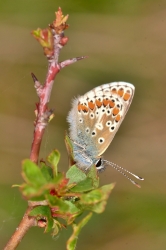 |  |
| Butser Hill and Ramsdean Down Photo © Ashley Whitlock | Brown Argus Photo © Ashley Whitlock | Small Purple Barred Moth Photo © Ashley Whitlock |
Butser Hill. For once the field trip started on a sunny note and in the sunny periods it was very warm, and as we ascended the very steep slopes many species were coming into view.There excellent counts of Small Copper and Green Hairstreak, these two species were seen in very good numbers, at one point there were three Small Coppers on a bare patch all within inches of each other which is quite unusual. One Hawthorn Bush had up to 5 Green Hairstreaks on it at once a very unusual occurrence, and several of these looked worse for wear. Excellent counts of Dingy Skippers and Grizzled Skippers as well. Brown Argus came into focus as we were nearing Ramsdean Down, and by this time the Cuckoo had been heard and we had had a real Purple Patch of good weather, and we didn't know where to look there was so much flying around. The main character the Duke of Burgundy didn't disappoint either, we saw well over (50) on the slopes of Butser and around to Grandfathers Bottom. Several well fattened females were resting in the cool wind away from the scrub line which gave good views of the fat abdomen with many eggs, and the six-legs supporting these rather plump individuals. In all we saw up to (12) species, others of note were Small Heath's and Common Blues. We also noted Common Lizard, Red Kites and Buzzards, Yellowhammers, Cinnabar Moths, and Double Vein, and what I think is a Small Purple Barred Moth and according to the manuals it shouldn't be out until late June /July?
Thank you all for coming especially the new faces, over the past couple of weeks it's been nice to see you. [Posted by Ashley Whitlock]
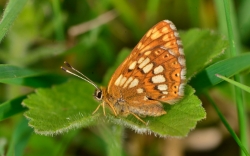 | 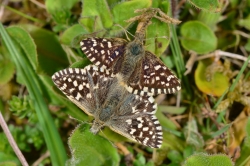 | 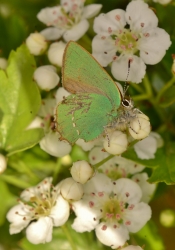 |
| Female Duke of Burgundy Photo © Ashley Whitlock | Mating pair of Grizzled Skippers Photo © Ashley Whitlock | Green Hairstreak and Hawthorn Photo © Ashley Whitlock |
Bentley Wood. A visit to the Eastern Clearing from 1000-1300 on a sunny but cool morning produced only only three species of butterfly, Brimstone 1, Grizzled Skipper 1, Pearl-bordered Fritillary 12, and also Speckled Yellow Moth 10. As usual the Fritillaries all vanished when the sun went in and by 1300 it was completely overcast. [Posted by Mark Pike]
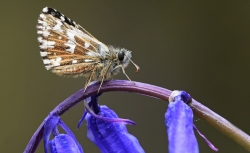 |  |  |
| Grizzled Skipper Photo © Mark Pike | Pearl Bordered Fritillary Photo © Mark Pike | Pearl Bordered Fritillary Photo © Mark Pike |
A Couple Of Pearls Brave Chill Wind In West Wood. A mid-afternoon visit to an area of regeneration in West Wood (Farley Mount) produced two fresh Pearl-bordered Fritillary (both male), despite the low air temperature and chill wind. One provided a few brief photo opportunities. The only other butterfly seen was a Peacock. [Posted by Alan Thornbury]
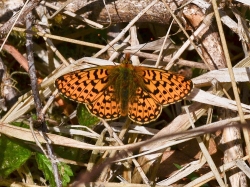 | 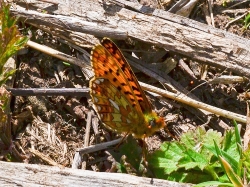 |
| Pearl-bordered Fritillary Photo © Alan Thornbury | Pearl-bordered Fritillary Photo © Alan Thornbury |
Monks Walk, Frater Fields & Woods, Gosport. A cool, overcast afternoon with occasional sunny periods took the temperature to no more than 13.5 degrees between 1230-1440. The butterflies were hard to find initially but later responded to longer spells of sunshine. However, only eight species were seen today. Promiscuous Small White was well represented and my third finding of a mating pair this Spring was welcome. An elegant Little Egret dipped in the foreshore rivulets watched - no doubt hungrily - by an equally impressive fox. Later still another lazy fox posed for the camera completely unfazed by my approach. The butterfly count: Small White (M)(8)(F)(2); Small Tortoiseshell (1); Peacock (1); Speckled Wood (9) including a female with particularly black hind wing spots; Green-veined White (4); Orange-tip (M)(1)(F)(1); Holly Blue (4); Large White (1). [Posted by Francis Plowman]
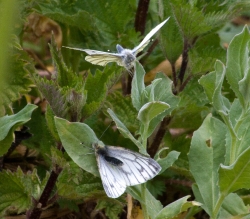 | 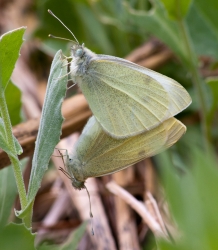 | 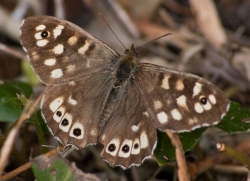 |
| Green-vein White (female lower) Photo © Francis Plowman | Small White (female uppermost) Photo © Francis Plowman | Speckled Wood with black hind wing spots Photo © Francis Plowman |
Fort Widley, Portsdown Hill. From 1420-1500 a short excursion around the Cowslip-bedecked fields behind and surrounding Fort Widley brought just one butterfly to light. Doubtless the cool breeze and overcast skies wasn't at all helpful. Common Blue (1). At least the blues are emerging here as well as on the southern slopes of Portsdown Hill. [Posted by Francis Plowman]
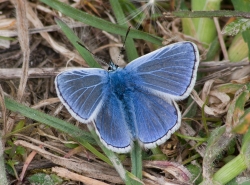 |
| Photo © Francis Plowman |
Portsdown Hill, Paulsgrove. Today I undertook most of Walk 18 (p.48 H&IW Butterfly Walks) between 1125-1300 when foreboding dark clouds saw me scurrying back to the car! At best the temperature was 16 degrees but the SW breeze was fresh and interfering. Nevertheless, seven species were found including a few Brimstone. The females were being harried by males but most of the former appeared to be egg-laying. One male forced a female to the ground but she, raising her abdomen upwards, eventually got through to her suitor who flew off disappointed no doubt. She then continued to lay single eggs on short, weedy plants. A first appearance (for me) this year of Common Blue and Green Hairstreak was very welcome. Altogether: Orange-tip (M)(2); Holly Blue (M)(4)(F)(1); Brimstone (M)(6)(F)(5); Common Blue (M)(1); Green Hairstreak (1); Speckled Wood (1); Small White (1). [Posted by Francis Plowman]
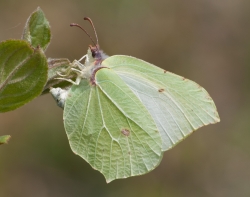 |  | 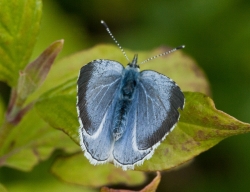 |
| Brimstone female egg-laying Photo © Francis Plowman | Common Blue male Photo © Francis Plowman | Holly Blue female Photo © Francis Plowman |
Oxenbourne Down / Wascoombe Bottom. The last of the warmish weather for a few days so I had to be quick on the slopes, and today I'm happy to report the Duke of Burgundy has double in numbers and some. (5) Dukes including a female were seen on the Gorse strewn downland. Typically this is a normal count for many sites in Hampshire, although I have had double figures at this site and there is another week or so before they are at their peak, so I'm hopeful they have a good year here. Other species who had good counts were Dingy Skipper (15), and the best count for Green Hairstreak at this site for many years (7). Other species of note Grizzled Skipper, Small Copper, Peacock, Small Heath, Small/Green-veined White, Brimstone, Orange-tip, Speckled Wood, Red Admiral, and a lovely Ermine Moth. [Posted by Ashley Whitlock]
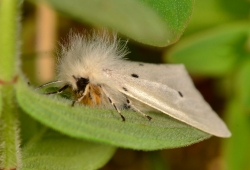 | 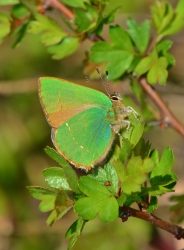 | 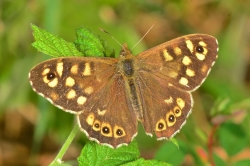 |
| Ermine Moth having a bad hair day Photo © Ashley Whitlock | Green Hairstreak Photo © Ashley Whitlock | Speckled Wood Photo © Ashley Whitlock |
Brown Hairstreak Larva, Soberton. Having found good numbers of Brown Hairstreak eggs over the winter (over 100 counted at my home site), locating the larvae is much more challenging, even having tagged the egg sites. So I was pleased to find this little one today (Photo 1) on the underside of a blackthorn leaf. I had also been wondering about feeding damage patterns from BrHS larvae, and this photo seems to provide some evidence that feeding is from the leaf margins, which might help in locating larvae.
I also found the another caterpillar (Photo 2) on more mature blackthorn leave, resting motionless, which I haven't been able to identify yet.
Photo 3 shows the egg case of a Brown Hairstreak ovum from the same site, after emergence of the larva through the micropyle (at the apex). [Posted by Angus McCullough]
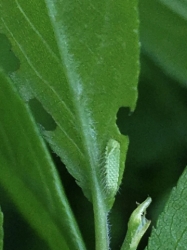 | 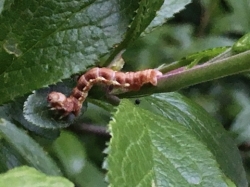 | 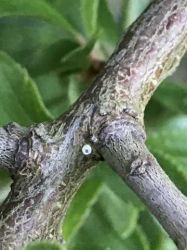 |
| Brown Hairstreak larva Photo © Angus McCullough | Geometrid moth caterpillar? Photo © Angus McCullough | Brown Hairstreak egg case Photo © Angus McCullough |